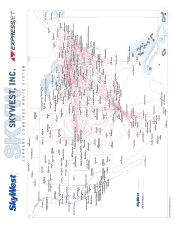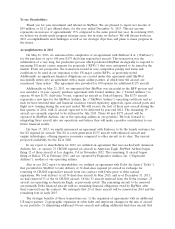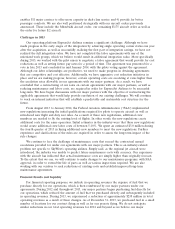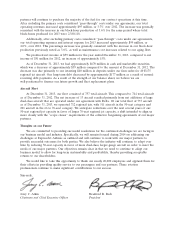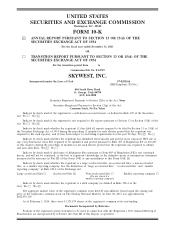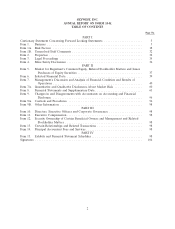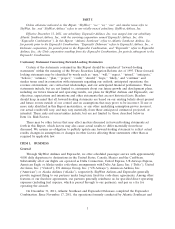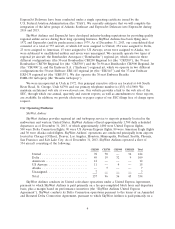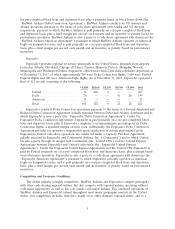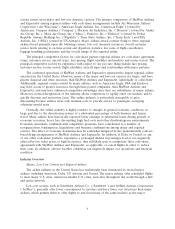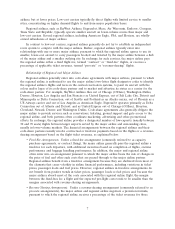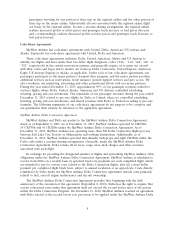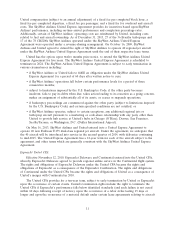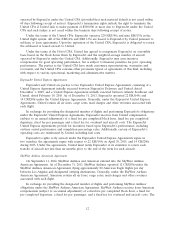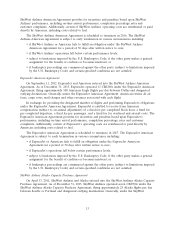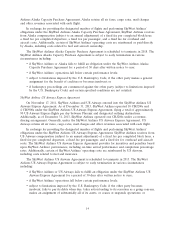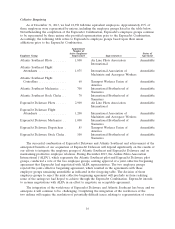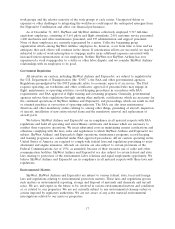SkyWest Airlines 2013 Annual Report Download - page 12
Download and view the complete annual report
Please find page 12 of the 2013 SkyWest Airlines annual report below. You can navigate through the pages in the report by either clicking on the pages listed below, or by using the keyword search tool below to find specific information within the annual report.airlines, but at lower prices. Low-cost carriers typically fly direct flights with limited service to smaller
cities, concentrating on higher demand flights to and from major population bases.
Regional airlines, such as SkyWest Airlines, ExpressJet, Mesa, Air Wisconsin, Endevor, Compass,
Trans State and Republic, typically operate smaller aircraft on lower-volume routes than major and
low-cost carriers. Several regional airlines, including American Eagle, PSA, and Horizon, are wholly-
owned subsidiaries of major airlines.
In contrast to low-cost carriers, regional airlines generally do not try to establish an independent
route system to compete with the major airlines. Rather, regional airlines typically enter into
relationships with one or more major airlines, pursuant to which the regional airline agrees to use its
smaller, lower-cost aircraft to carry passengers booked and ticketed by the major airline between a hub
of the major airline and a smaller outlying city. In exchange for such services, the major airline pays
the regional airline either a fixed flight fee, termed ‘‘contract’’ or ‘‘fixed-fee’’ flights, or receives a
percentage of applicable ticket revenues, termed ‘‘pro-rate’’ or ‘‘revenue-sharing’’ flights.
Relationship of Regional and Major Airlines
Regional airlines generally enter into code-share agreements with major airlines, pursuant to which
the regional airline is authorized to use the major airline’s two-letter flight designator codes to identify
the regional airline’s flights and fares in the central reservation systems, to paint its aircraft with the
colors and/or logos of its code-share partner and to market and advertise its status as a carrier for the
code-share partner. For example, SkyWest Airlines flies out of Chicago (O’Hare), Washington Dulles,
Denver, Houston, Los Angeles and San Francisco as United Express, out of Salt Lake City, Detroit and
Minneapolis as Delta Connection, out of Seattle and Portland as an Alaska carrier, out of Phoenix as a
US Airways carrier and out of Los Angeles as American Eagle. ExpressJet operates primarily as Delta
Connection out of Atlanta and Detroit; and as United Express out of Chicago (O’Hare), Houston,
Cleveland, Newark, Denver and Washington Dulles. Code-share agreements also generally obligate the
major airline to provide services such as reservations, ticketing, ground support and gate access to the
regional airline, and both partners often coordinate marketing, advertising and other promotional
efforts. In exchange, the regional airline provides a designated number of low-capacity (usually between
30 and 70 seats) flights between larger airports served by the major airline and surrounding cities,
usually in lower-volume markets. The financial arrangements between the regional airlines and their
code-share partners usually involve contractual or fixed-fee payments based on the flights or a revenue-
sharing arrangement based on the flight ticket revenues, as explained below:
•Fixed-Fee Arrangements. Under a fixed-fee arrangement (commonly referred to as capacity
purchase agreements, or contract flying), the major airline generally pays the regional airline a
fixed-fee for each departure, with additional incentives based on completion of flights, on-time
performance and baggage handling performance. In addition, the major and regional airline
often enter into an arrangement pursuant to which the major airline bears the risk of changes in
the price of fuel and other such costs that are passed through to the major airline partner.
Regional airlines benefit from a fixed-fee arrangement because they are sheltered from most of
the elements that cause volatility in airline financial performance, including variations in ticket
prices, passenger loads and fuel prices. However, regional airlines in fixed-fee arrangements do
not benefit from positive trends in ticket prices, passenger loads or fuel prices and, because the
major airlines absorb most of the costs associated with the regional airline flight, the margin
between the fixed-fees for a flight and the expected per-flight costs tends to be smaller than the
margins associated with revenue-sharing arrangements.
•Revenue-Sharing Arrangements. Under a revenue-sharing arrangement (commonly referred to as
pro-rate arrangements), the major airline and regional airline negotiate a proration formula,
pursuant to which the regional airline receives a percentage of the ticket revenues for those
7


